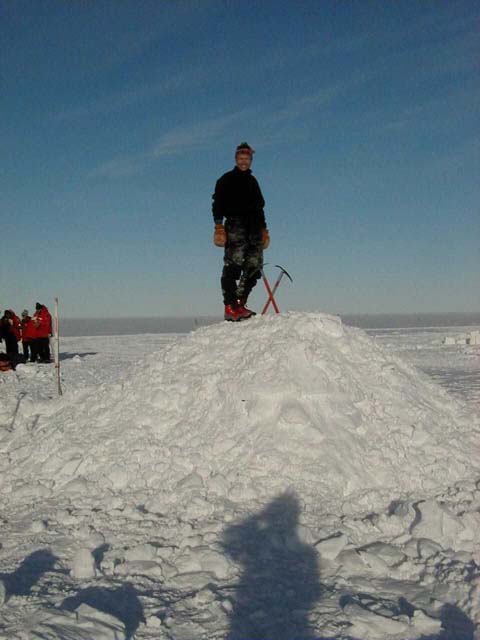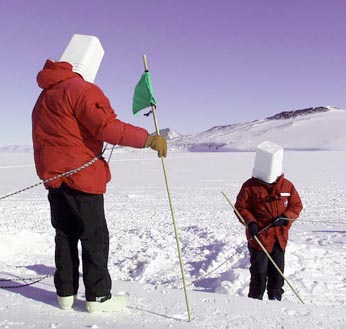28th October 1999
Greetings from Antarctica. I am currently waiting for a helicopter flight back to Lake Hoare, my home for the next three months. The helos have been grounded temporary because of a storm that blew in last night from the sun. It was my first taste of bad weather since I arrived last week. I flew into McMurdo last Tuesday from Christchurch. Getting off the C141 airplane onto the ice that currently occupies the Ross Sea I was awed by an impressive sight of snow capped mountains and miles and miles of ice. Expecting extremely cold temperatures we all were bundled up, but we were treated to a warm (about 20 F) and sunshine. Still it is quite a contrast from the green, lush and sheep-filled landscape of New Zealand. No trees, plants, birds or animals in sight, just a sea of ice and mountains framing the background.
I consider myself lucky on my first adventure south, since most people have to wait quite awhile trying to get McMurdo because of the weather. You are probably familiar with this process since you have been down before. I have heard stories of folks make it as far as seeing Antarctica, but have to turn around because the runway has poor visibility and this happens many times, before reaching McMurdo, or Mac town as it known down here. The hardest part about the flight was being packed in like sardines, with the seating consisting of mesh netting. Most of the flight consisted of standing on my seat, trying to relieve my tired bottom. I was thankful to walk out onto the ice and stretch.
I spent the first week in McMurdo preparing for the field and getting all of my necessary training. I had to get a drivers license, go through snow school, learn about the waste management protocol, be educated on the risk of traveling in the region near McMurdo, shown how to be a good passenger on a helicopter and glacier travel and crevasse rescue. The recycling program is very impressive. Everything except gray water here in McMurdo is either recycled, reused or sent back to the state of Washington for incineration. Also the research facilities the US Antarctica Program has established here in McMurdo is amazing. The research lab is top notch and there are quite a large group of folks who support the scientist here and in the field. Most things that I need for the field can be obtained from someone, somewhere. Besides the facilities, all of the folks working here are great and very helpful. It is definitely a dream place to do research.
As for my snow school or as it is otherwise known as 'Happy Campers School' I survived.
Twenty-four happy campers, including myself, were ferried out to the ice shelf in a two-tracked vehicle, suitable for travel in deep snow. The camp is
located in a spot, which is appropriately exposed to the worst of the elements, just in sight of Scott Base, which is the main kiwi (New Zealand) base in
Antarctica. We were fortunate to have sunny and relative mild temperatures (5-10F), though the occasional breeze blowing across the ice shelf made
the wind chill drop precipitously. Wow, the wind down here just cuts through me like a knife. For example today's high is forecasted to be -11C/+12F,
but with wind-chill it will be -41C/-43F. To keep ourselves
warm we learned at camp how to build snow walls for the tents, a quinsy, which I slept in
that night and a snow trench. We also went over how to start the camping stoves in the cold weather, plus different tricks on how to stay warm
and dry. I spent most to the afternoon digging out the snow cave I slept in. The quinsy was just big enough to sit up in and provided a good block
from the wind. I would have had a good night sleep if it were not for my roommate's constant and loud snoring.

The second day of camp we learned how to use the various radios provided to us, plus how to rescue a person who is lost during the storm. For that we all placed white buckets (to simulate a white out, of coarse) on our heads and proceeded to scan the area by staggering people out on a rope to for the lost soul. Quite a funny sight to see a string of people strung out with buckets over their heads. It did give us a taste, though, what it would be like to be in a severe storm trying to find someone.

This past Monday I flew out to my new home, Lake Hoare, which is located in Taylor
Valley. The valley is one of several what is called the McMurdo Dry Valleys. They are called dry, because they are the largest ice-free area in Antarctica.
Glaciers, which are the focus of the Andrew's group, do flow into the valley, but the remainder of the valley is just soil. Three lakes, plus several
smaller ones, exist along the axis of the valley. The three are called Bonney, Hoare and Fryxell. The surface of each lake is frozen down to about 40 feet
from the surface. The temperature at camp will be about 5-10F warmer than McMurdo, hence it is known as the banana belt of Antarctica. The camp I am
staying at is fairly basic. There is a main building, which has a
kitchen, eating area, some bunk beds and an office. There are three smaller lab buildings,
plus some other utility sheds and a jamesway, which is canvas tent with a semi-circular frame. My tent has a wonderful view of the very steep faced
Canada Glacier. The glacier is only a couple of hundred feet away. The glacier and the camp lie at the edge of Lake Hoare. The surface of the lake is
completely frozen, but in a month or so, the edges where the ice is thin will melt out. It will make it more difficult to get around, since presently the
lake acts as road. You can see pictures of the camp, plus other spots in the valley if you go to the LTER home page. The address is http://huey.colorado.edu/LTER/pictures.html.
Currently there are 5 people besides myself at camp. More folks will come and go as the season progresses. My first couple of days at camp was chaotic, since I was trying to get situated in my new surroundings, while starting the various tasks I have to complete while I am here. It should get easier as I get into a routine. I didn't sleep well the first night in my tent, mainly because of the light, but the second night I wised up and pulled over a hat over my eyes. The sun does go behind the mountains at camp from the afternoon to early morning, but it is still light. The next sunset is not until February 21. The temperature has been a balmy +5F to +15F and winds unusually light
My duties the week and the next will be focused on downloading data from the 10 meteorological stations that are located in Taylor, Wright and Victoria Valleys. Three of the stations are accessible from camp, the others I will have to have helicopter support. Once I finished with the stations I will start tromping around on the glaciers, measuring the distance from the top of the many stakes drilled vertically into the glaciers to the glacier surface. This gives us an indication of the change in the mass of the glaciers in Taylor Valley. There are several other projects I have going, plus helping out with the other teams down here.
Hope everyone is well in Portland.
Sincerely,
Thomas